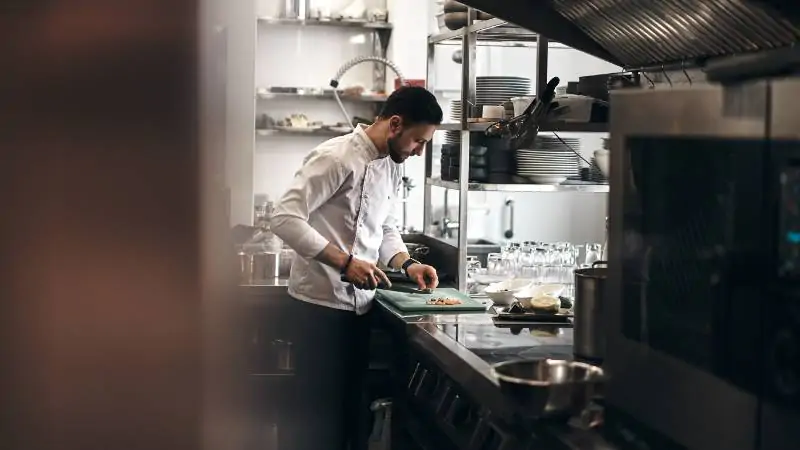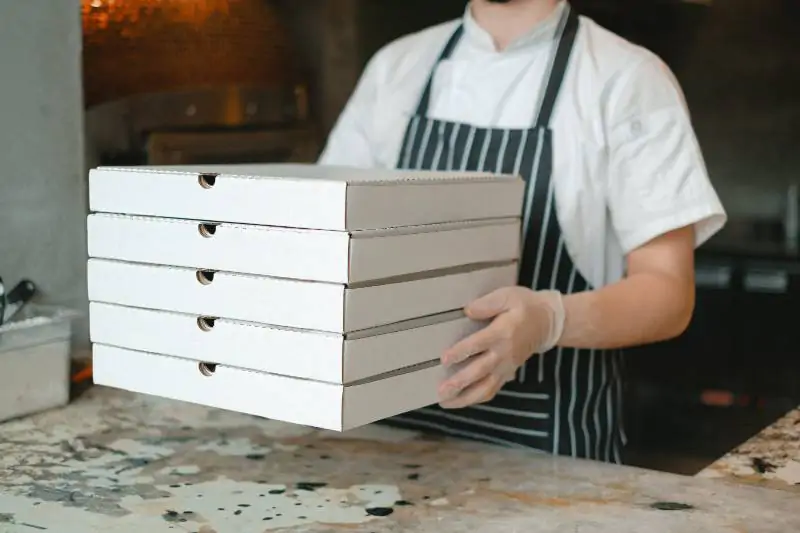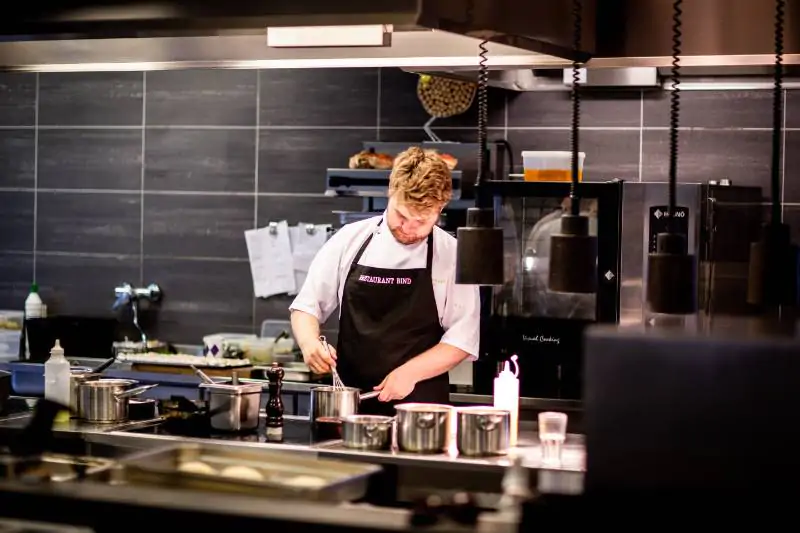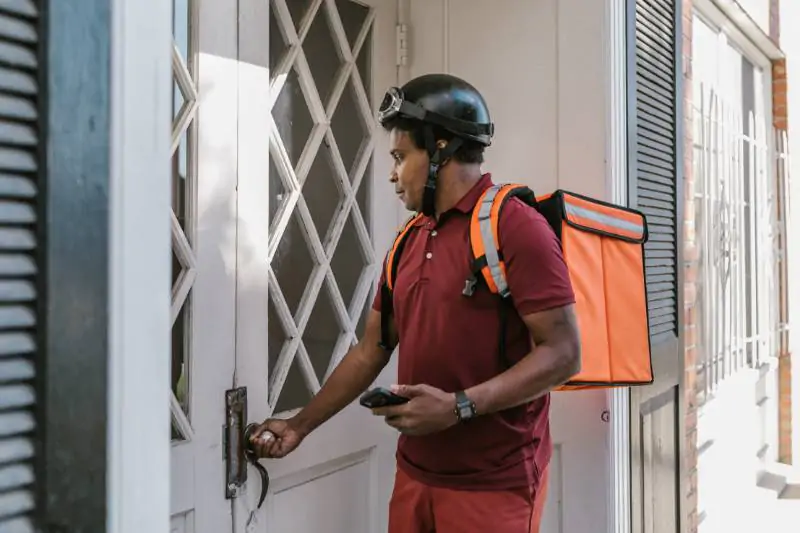Ghost kitchen guide: What is a ghost kitchen and how do they work?


In recent years, the food service industry has witnessed a significant rise in the popularity of takeaway food, which has stayed consistently high since coronavirus lockdowns. With this, we’ve seen the emergence of a relatively new culinary concept: the ghost kitchen. Also known as dark kitchens, virtual restaurants, or cloud kitchens, ghost kitchens have become a key part of the food business landscape, offering a cost-effective and innovative way for both new and existing food businesses to enter the world of food delivery.
In this comprehensive guide, we’ll take a closer look at the world of ghost kitchens, exploring what they are, how they operate, and the benefits that come with running them. We’ll also give you some handy tips for setting up your own ghost kitchen, including looking at start-up costs and business plans.
- What is a ghost kitchen?
- The benefits of running a ghost kitchen
- How to start a ghost kitchen
- Important considerations when running a ghost kitchen business
What is a ghost kitchen and how do they work?


A ghost kitchen is a commercial kitchen designed exclusively for the preparation of food for delivery and takeaway orders. Ghost kitchens operate on a simple yet highly efficient model. Unlike traditional restaurants or eateries, ghost kitchens do not have a seating area where customers can dine in. Instead, they work by operating behind the scenes, focusing solely on preparing and packaging takeaway dishes. They often pair with a food delivery app to make deliveries as simple as possible, and as transactions are made online, they are usually cashless businesses too.
What are the different types of ghost kitchens?
While the basic premise of being delivery only businesses is the same, ghost kitchens come in various forms to cater to different business models and customer needs. Below are the main types of ghost kitchens, and how they operate.
Single-brand ghost kitchens
The classic form of ghost kitchen, and one of the most commonly found, is a traditional single-brand ghost kitchen. As the name suggests, this type of dark kitchen focuses on a single restaurant brand, offering a limited menu with a specific cuisine. Single-brand ghost kitchens are ideal for established restaurant chains looking to expand their delivery and takeout services.
Multi-brand ghost kitchens
Multi-brand ghost kitchens operate under a single roof but house multiple restaurant concepts. These kitchens can offer a range of cuisines and menus to cater to a broader customer base. They are perfect for entrepreneurs looking to test multiple concepts with lower overheads.
Commissary or shared kitchens
These kitchens serve as shared spaces where multiple restaurants or food businesses work in the same facility. Commissary kitchens are cost-effective and provide an opportunity for startups to minimise initial investment.
Hybrid kitchens
Hybrid ghost kitchens combine the ghost kitchen concept with traditional dine-in restaurants. They may use the same kitchen space for both dine-in and delivery orders, optimising the use of resources.
Franchise models
Some ghost kitchen brands offer franchise opportunities for entrepreneurs. This allows individuals to operate their own ghost kitchens under a recognised brand, benefiting from established menus and marketing support. This can be a great option for those just getting started in the business.
The benefits of running a ghost kitchen


Running a ghost kitchen offers a range of benefits for both those completely new to the industry and established restauranteurs alike. Below are some of the key advantages of operating a ghost kitchen.
Cost-effective operations
One of the most significant advantages of ghost kitchens is the cost savings they offer. Without the need for a traditional storefront, dining area, or front-of-house staff, ghost kitchens can significantly reduce overhead costs, such as rent and utilities. This cost efficiency allows ghost kitchen operators to allocate resources to other critical aspects of their business, such as investing in higher quality kitchen appliances and premium ingredients.
Lower barrier to entry
Ghost kitchens provide an excellent opportunity for newcomers to the food industry. The reduced initial investment and lower overhead costs make it more accessible for aspiring chefs and entrepreneurs to start their culinary ventures. This is particularly appealing for those who want to test their concepts in a cost-effective manner.
Geographic flexibility
Since ghost kitchens don't rely on a traditional storefront, they can be set up in a variety of locations. This geographic flexibility allows businesses to target specific delivery zones and easily move or expand to new areas as needed. It's also easier to adapt to changing conditions in the hospitality sector by relocating or opening multiple kitchens in strategic areas.
Enhanced efficiency
Ghost kitchens are designed for efficiency. The absence of dine-in customers means that the entire kitchen is designed solely for food preparation and packaging. This not only results in faster order fulfilment and consistent quality, which makes it easier to meet customer expectations, but it also minimises the number of unexpected occurrences that can pop up and lead to delays in a traditional dine-in eatery.
Adaptability
Ghost kitchens can quickly adjust their menus to accommodate changing consumer tastes and trends. This adaptability is especially valuable in a dynamic culinary landscape where preferences can shift rapidly.
Data-driven insights
As ghost kitchens don’t have traditional storefronts and tend to be exclusively online, they use digital ordering and delivery platforms. This can be beneficial for getting a better understanding of the current market, as these platforms can provide valuable data on customer behaviour, preferences, and order patterns. Operators can use this data to refine their menu, marketing strategies, and operational processes, ultimately improving the customer experience.
Scalability
Ghost kitchens can scale up quickly and efficiently. As demand grows, operators can expand their kitchen space, add more delivery drivers, and explore new delivery zones. This scalability is an essential advantage for businesses looking to grow rapidly.
How to start a ghost kitchen


Starting a ghost kitchen involves several crucial steps, from choosing where to set up and setting your budget, to designing your menu and creating a comprehensive business plan. Here's all the essential advice you need to help you get started on your ghost kitchen journey.
Setting your budget
The first step in starting a ghost kitchen is to determine your budget and secure the necessary funding. The initial costs will vary based on factors such as location, kitchen size, equipment, and marketing expenses. Here are some of the main ghost kitchen startup costs to consider when setting your budget:
· Kitchen space: The cost of buying or renting the kitchen space will be a significant portion of your budget (unless you already own an eatery and plan on using the same kitchen for your ghost kitchen set-up). Consider factors like location, size, and the condition of the space.
· Equipment: Just like setting up a food truck, bakery, or any other type of food business, your ghost kitchen will require a number of essential kitchen appliances, from larger products like ovens and refrigeration equipment, to smaller but still vital kitchenware such as utensils and knives.
· Staffing: Although staffing costs will be lower than other in-person businesses, you will still need to hire kitchen staff. You may also want to employ your own delivery drivers and a customer service representative for order management and support.
· Licences: If you plan on selling hot food between 11pm and 5pm, you will need a premises licence. You can find out more about these in our alcohol laws guide. You will also need to register with your local council at least four weeks before you start trading, although this is free.
· Technology and software: Budget for the development or purchase of a user-friendly website or mobile app for online ordering, as well as POS (Point of Sale) systems. This is an especially important consideration for ghost kitchens, as all transactions will occur online.
· Packaging supplies: Invest in high-quality packaging materials to ensure that your food arrives at its destination in optimal condition.
· Marketing and branding: Although not as big an expense as the other ghost kitchen startup costs, a marketing and advertising budget is essential. Customers will only be able to find your business online, so an appealing online presence is crucial for success.
· Working capital: Set aside a portion of your budget for working capital to cover day-to-day operating expenses, including utilities, insurance, and unforeseen costs.
· Contingency fund: It's also wise to set aside a contingency fund for unexpected expenses or slow initial business growth.
Location selection
A crucial decision when setting up a ghost kitchen is to choose a strategic location. While traditional restaurants rely on high-foot-traffic areas, ghost kitchens often opt for more cost-effective locations in commercial or industrial areas. The goal is to minimise overhead costs while ensuring easy access to delivery routes. Before deciding your location, make sure that it is served by all the main delivery apps. You may also want to take a look at the competition in the area before deciding on your location. While this tends not to be as important a consideration as it would be for a brick-and-mortar food business, you may be able to attract a higher percentage of customers if your ghost kitchen fills a gap in the market.
Finding your niche
Identifying your niche in the competitive food delivery market is essential for the success of your ghost kitchen. The main consideration to make here is your cuisine and menu. You should ideally choose a cuisine that aligns with your expertise and passion. You should also determine what sets your ghost kitchen apart from others by finding your unique selling point (USP). This could be anything from a special recipe, a creative twist on a classic dish, a new type of fusion dish, or even a commitment to creating a sustainable food business.
Make sure that customers are able to get a good understanding of your niche and USPs by developing a strong brand identity that resonates with your niche. Your brand should reflect the values and aspirations of your target customers. This will primarily be done via your online presence, as this is how customers will connect with your ghost kitchen. Ensure that your website and online ordering system are user-friendly and tailored to your niche, with a menu, images, and descriptions that all appeal to your target market.
Designing your menu
Creating a menu for your ghost kitchen requires careful planning and consideration. The menu is the heart of your business and should reflect your niche and brand. Here are the steps to design an effective ghost kitchen menu:
· Keep it simple: Ghost kitchen menus are typically smaller than traditional restaurant menus. Focus on a concise selection of dishes that can be prepared quickly and consistently to get as many orders in as possible.
· Consider packaging: Choose menu items that package well and maintain their quality during delivery. Avoid items that are highly perishable or lose their appeal when not served fresh.
· Data analysis: Ghost kitchens can use data analytics to gain insights into customer preferences, peak order times, and popular menu items. This data can be used to optimise menu offerings and marketing strategies. Leverage this data to update your menu when necessary.
· Online ordering system: Ensure that your online ordering system is user-friendly, with clear menu categories, descriptions, and the ability for customers to customise their orders as needed.
· Food imagery: High-quality, professionally photographed images of your dishes can significantly impact customer choices, especially as customers cannot see the dishes with their own eyes until they make their order. Include images of your menu items on your website and online ordering platforms.
As well as these specific ghost kitchen menu considerations, you should also take into account general menu creation tips, such as ensuring you include dishes catering to a variety of dietary options, have some seasonal offerings, and have enticing and informative menu item descriptions. You can find out more menu tips in our guide to creating a food menu.
Creating a ghost kitchen business plan
Once you have the key details in place, you can gather your thoughts and make a more comprehensive guide in the form of a ghost kitchen business plan. A comprehensive business plan is essential for the success of your ghost kitchen venture. It serves as a roadmap, guiding your business decisions, and can also help you secure funding if needed. Your business plan should include the following elements:
· Executive summary: An overview of your ghost kitchen, its mission, and its unique selling proposition.
· Business description: Detailed information about your ghost kitchen concept, location, and niche.
· Market analysis: Research your target market, including customer demographics, competitors, and delivery service preferences.
· Marketing and sales strategy: Your approach to marketing and how you plan on promoting your ghost kitchen, including online marketing, social media, and partnerships with delivery apps.
· Menu and pricing: Details about your menu, pricing strategy, and any seasonal or special offerings.
· Operational plan: Information about your kitchen setup, staffing, and the technology you'll use for order management.
· Financial projections: Projections for revenue, expenses, and profit margins. Include a break-even analysis and a plan for funding and capital requirements.
· Legal and regulatory considerations: Information about licenses, permits, and compliance with food safety regulations.
· SWOT analysis: A review of your ghost kitchen's strengths, weaknesses, opportunities, and threats.
· Risk assessment: Identify potential risks and challenges and outline your strategies for mitigating them.
Investing in the right equipment
Unlike traditional restaurants, which need space for dining, ghost kitchens prioritise kitchen equipment, prep stations, and packaging areas. The good news is that this allows the budget to stretch further when it comes to food preparation and cooking equipment. This means you can invest in less common appliances, such as dehydrators and thermal mixers, to allow you more freedom when it comes to updating your menu and can give you an edge over your competitors.
Other essential kitchen tools and appliances to invest in include:
· Reliable refrigeration equipment
· Oven and hobs
· Fryers
· Food warmers: This is especially important for ghost kitchens for keeping food warm while waiting for pickup
Important considerations when running a ghost kitchen business


There are several considerations that are especially important for those looking to set up a ghost kitchen. Here, we’ll take a closer look at them and give you tips on how you can use them to help your business thrive.
Marketing
Marketing is important for any food business, but it plays a particularly pivotal role in the success of a ghost kitchen. Unlike a restaurant or café, customers cannot come across your business by simply wandering around, so you need to make sure you reach your target demographic through marketing.
One of the best ways to do this is to establish a strong digital presence. The most essential thing when doing this is to create a user-friendly website that is optimised for mobile devices. Make sure it showcases your menu, pricing, and ordering options to make ordering from your business as easy as possible. You should also optimise your website and content for search engines. Use relevant search engine optimised (SEO) keywords in your website copy, meta descriptions, and blog posts to do so. There are several tools online you can use to find the best keywords to target, such as ahrefs, Semrush, and Ubersuggest.
Another effective way to boost your online presence and promote your business is being active on the main social media platforms, including Facebook, Instagram, Twitter, and TikTok. Not only is this an effective way to reach new potential customers, but it is a completely free way to promote your business — although you can also reach even more customers by paying to advertise on these sites if you wish.
Regularly post high-quality images of your dishes and engage with your followers often. You can also host contests, promotions, and giveaways to increase brand visibility. You may want to consider collaborating with social media influencers and bloggers too, allowing them to review and promote your ghost kitchen. And don’t forget to use social media to encourage customers to leave reviews and feedback on platforms like Google and TripAdvisor, in order to build trust and credibility.
You can expand your online presence even further partnering with food delivery platforms and apps such as Deliveroo, UberEats, and JustEat. These platforms often allow businesses to run promotions with them to entice customers.
Packaging
Proper packaging is crucial for ghost kitchens as it not only ensures the food's quality but also contributes to the overall customer experience. Here are essential considerations when it comes to packaging your dishes:
- Quality and durability
Invest in high-quality packaging materials that can maintain the freshness and temperature of your food during delivery. Ensure packaging is durable and leak-proof to prevent spills and food damage during transportation.
- Branding and presentation
Use custom packaging with your ghost kitchen's logo and branding to create a memorable and professional impression.
- Sustainability
Although not essential, opting for eco-friendly packaging can help you lower the carbon footprint of your business and make your ghost kitchen more appealing to environmentally-conscious customers.
- Temperature control
: For hot food items, use heat-resistant packaging that retains warmth. For cold items, use insulated containers or cool packs to maintain freshness.
- Portion control
Avoid overfilling your takeaway containers as this can lead to spills and can be bad for food presentation too. You can use a range of portioners to help your chefs serve up the perfect amount every time.
- Sealing and labelling
Seal containers securely to prevent tampering and spillage. Clearly label all packages with item names to make it easier for customers to serve up the dishes at home. You may want to add reheating instructions on the packaging for those who want to save some of their meal as leftovers.
Delivery apps
Ghost kitchens heavily rely on food delivery apps to reach a broad customer base. Using these platforms comes with many advantages, such as not having to employ your own delivery drivers and making your ghost kitchen more visible online. Rather than sticking to just one, establish partnerships with several of the most popular food delivery apps. This will help you expand your reach to a wider customer base, and can also be useful if one of these apps is experiencing technical difficulties. You might also want to consider partnering with lesser-known delivery apps where there will likely be less competition from other ghost restaurants.
When using these platforms, ensure you set realistic preparation and delivery times. Not only will this prevent customer dissatisfaction, but it will reduce the pressure on your kitchen staff. The good news is that as the menus are smaller and there are no dine-in areas, ghost kitchens tend to have quicker delivery times than standard restaurants anyway.
The ghost kitchen business model is a fantastic option for those established in the hospitality industry and newcomers to the food sector alike. With the information and advice above, we hope you feel confident when it comes to setting up your own virtual restaurant. A strong online presence and premium quality products can allow your dark kitchen to thrive and maybe even be the start of a blossoming business.
We’ve got some of the essential tools you need to get your business off the ground here at Mitchell & Cooper, including catering appliances, commercial cookware, kitchenware, and storage and handling essentials. Explore our full collection today.
And don’t forget to check out the rest of our guides, inspiration pieces, and blog posts for even more industry news, tips, and advice.
